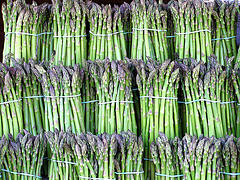It seems like most of North America is a lot closer to summer, while the Avalon is still in early spring mode. That being said, there's a big advantage to this: spring crops can get a second (or third) round before the heat starts. As well, while we may not have had a lot of sun, we've had plenty of rain, which is great for some plants. The question then becomes, what do we do with all the extra? I have one word for you: PICKLING.
A lot of people associate pickling with the fall; beets, cucumbers, late-crop beans and the like. Personally, I think that a lot of spring veggies get even better with a good dose of brine! So, with that, here are a few recipes to capture spring in a bottle of herbs, vinegar and salt.
Asparagus is reaching the end of its season in Eastern parts of Canada, but if you can find some fresh stuff, Pickled Asparagus is a real treat. This recipe, courtesy of WellPreserved.ca (a blog run by a fantastic couple in Toronto) would also work for my favourite pickle in the world, Pickled Garlic Scapes.
Speaking of Pickled Garlic Scapes, Washington's Green Grocer has a very interesting spin on them, including flowers in the final product!
Just about everyone I know has access to at least one rhubrarb plant, which isn't surprising since it grows like a weed! I love the tart flavour of rhubarb, so I'm very curious to try giving it a dose of brine!
And finally, need to clear out some of those turnip greens before they go bad? Why not give try this Pickled Mustard Greens recipe a try? The basic principle would be the same, and you'd have a really interesting side dish for spicy stir fries or BBQ skewers.






